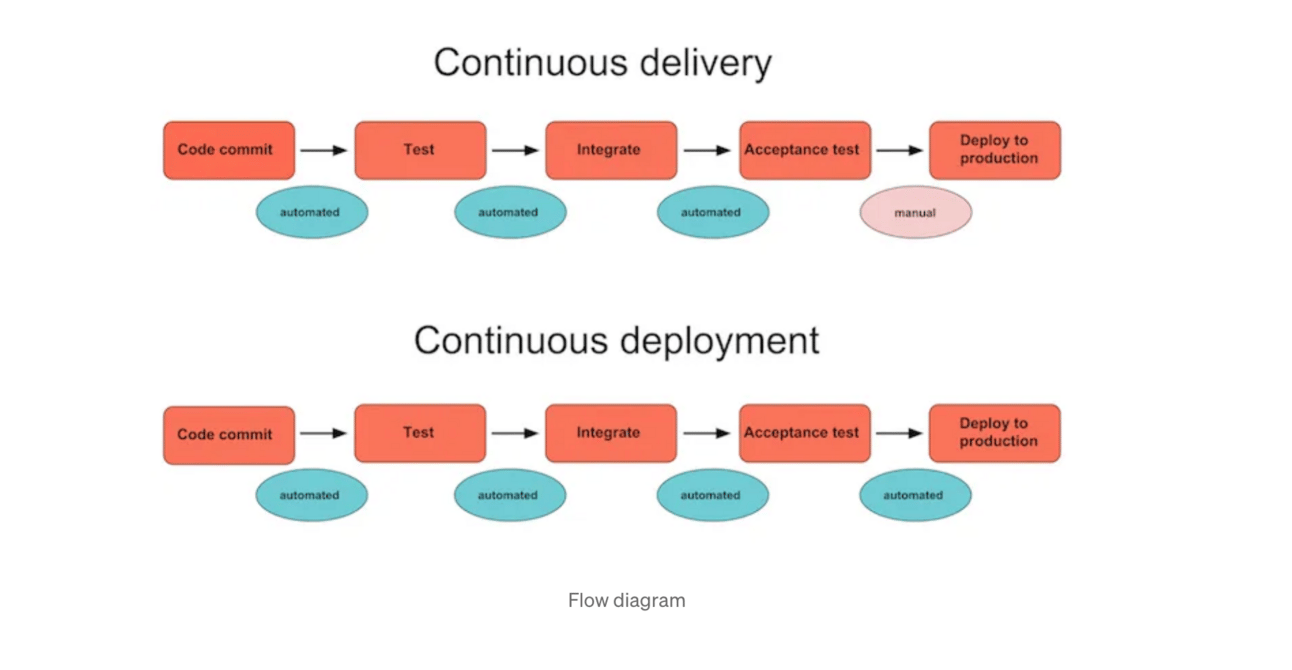- DevOps Weekly
- Posts
- Continuous Delivery (CD) vs. Continuous Deployment: What’s the Difference and Why It Matters
Continuous Delivery (CD) vs. Continuous Deployment: What’s the Difference and Why It Matters
In this article, we’ll discuss the difference between Continuous Delivery (CD) and Continuous Deployment, and how they help you release software faster and more reliably. Learn why they matter, how they improve customer experience, and see real-world examples from companies like Netflix and Amazon. Discover which approach is right for your team to deliver value like a pro.

Hello “👋”
Welcome to another week, another opportunity to become a great DevOps and Software Engineer
Today’s issue is brought to you by DevOpsWeekly→ A great resource for devops and backend engineers. We offer next-level devops and backend engineering resources.
In the fast-paced world of software development, delivering value to customers quickly and reliably is critical. Two key practices—Continuous Delivery (CD) and Continuous Deployment-help teams achieve this. While they sound similar, they serve different purposes and have distinct impacts on customer experience and business outcomes. Let’s break it down.
Key Differences and When to Use Each
Continuous Delivery (CD):
What it is: Automates the process of preparing code changes for release but requires a manual trigger to deploy to production.
When to use it: Ideal for teams that need final human approval before releasing to customers (e.g., for compliance, risk management, or strategic timing).
Example: A financial app might use CD to ensure regulatory compliance before deploying updates.
Continuous Deployment:
What it is: Automates the entire pipeline, including deploying code changes to production without human intervention.
When to use it: Best for teams with robust testing and monitoring systems, where speed and frequent releases are critical.
Example: A social media platform might use continuous deployment to roll out new features or bug fixes instantly.
How CD Impacts Customer Experience and Business Outcomes
Faster Time-to-Market:
Both practices reduce the time it takes to deliver new features or fixes, keeping customers happy and engaged.
Example: Netflix uses continuous deployment to roll out updates multiple times a day, ensuring a seamless streaming experience.
Improved Quality:
Automated testing in CD pipelines catches bugs early, reducing the risk of production failures.
Example: Etsy’s CD pipeline includes thousands of automated tests, ensuring high-quality releases.
Better Risk Management:
Continuous Delivery allows teams to control when updates go live, minimizing risks associated with unexpected issues.
Example: A healthcare app might use CD to ensure critical updates are deployed during low-traffic hours.
Enhanced Customer Trust:
Frequent, reliable updates show customers that the product is actively maintained and improved.
Example: Amazon’s continuous deployment strategy helps it deliver new features and fixes without downtime, building customer loyalty.
Real-World Examples of Successful CD Implementations
Netflix:
Uses continuous deployment to update its platform multiple times a day.
Result: Faster feature rollouts and minimal downtime, keeping users engaged.
Etsy:
Implemented a robust CD pipeline with extensive automated testing.
Result: Reduced deployment times from hours to minutes and improved code quality.
Amazon:
Deploys code every 11.7 seconds on average, thanks to continuous deployment.
Result: Rapid innovation and a highly reliable e-commerce platform.
Google:
Uses both CD and continuous deployment across its services, enabling frequent updates and experiments.
Result: A culture of innovation and continuous improvement.
Practical Insights for Choosing the Right Approach
Choose Continuous Delivery if:
You need manual approval before releasing to production.
Your industry requires strict compliance or risk management.
You’re still building confidence in your automated testing.
Choose Continuous Deployment if:
You have a mature testing and monitoring system.
Speed and frequent releases are critical to your business.
You want to fully automate your release process.
Both Continuous Delivery and Continuous Deployment empower teams to deliver value faster and more reliably. The choice depends on your business needs, risk tolerance, and technical maturity. By adopting either practice, you can enhance customer experience, improve business outcomes, and stay competitive in today’s digital landscape.
Start small, automate incrementally, and watch your team’s efficiency-and your customers’ satisfaction-soar.
P.S. If you found this helpful, share it with a friend or colleague who’s on their DevOps journey. Let’s grow together!
It will help if you forward or share this email with your friends and leave a comment to let me know what you think. Also, if you've not subscribed yet, kindly subscribe below.
See you on Next Week.
Remember to get Salezoft→ A great comprehensive cloud-based platform designed for business management, offering solutions for retail, online stores, barbershops, salons, professional services, and healthcare. It includes tools for point-of-sale (POS), inventory management, order management, employee management, invoicing, and receipt generation.
Weekly Backend and DevOps Engineering Resources
DevOps and Backend Engineering Basics by Akum Blaise Acha
DevOps Weekly, Explained by Akum Blaise Acha
Simplifying Operating System for Backend DevOps Engineers by Akum Blaise Acha
Why Engineers Should Embrace the Art of Writing by Akum Blaise Acha
From Good to Great: Backend Engineering by Akum Blaise Acha
Web Servers for Backend and DevOps Engineering by Akum Blaise Acha
Reply